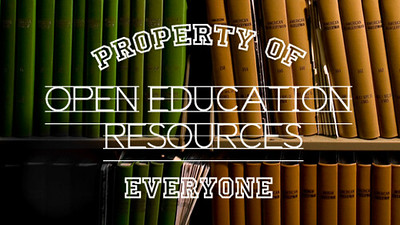A Quick Guide to OER for St. Clair College by St. Clair College is licensed under a Creative Commons Attribution-NonCommercial-ShareAlike 4.0 International License, except where otherwise noted.
St. Clair College
Windsor, Ontario
A Quick Guide to OER for St. Clair College by St. Clair College is licensed under a Creative Commons Attribution-NonCommercial-ShareAlike 4.0 International License, except where otherwise noted.
1

2
This Quick Guide was created by faculty and students as part of an eCampus Ontario-funded Digital Access Project led by the Centre for Academic Excellence at St. Clair College. This is a remix of existing Creative Commons learning material and original content specific to faculty and students at St. Clair College.

In addition to attributions provided in each chapter, we want to acknowledge all the works used and remixed here:
3
I
1

Copyright refers to the legal right of the owner/creator/producer of an original work to have full control of the distribution, reproduction, performance, or publication of that work.
Copyright is an important right that needs to be respected. It safeguards the rights and ownership of someone else’s work, protecting the integrity and dissemination of those works. This is especially important when you are thinking about which works to include in your own course.
At first, this might seem like an overwhelming landscape when choosing resources for your course and trying to determine what is or isn’t protected under copyright laws. But just know that you are not alone when navigating these scenarios. Your primary resource at St. Clair College will be Policy 4.7 Copyright Guidelines. Here you can find guidance on different permissions including what and how much you can freely copy for purposes of your course or other academic work. You can also reach out to the Library Resouce Centre or the CAE for specific questions that you may have.
While you are deciding on what resources to include in your course, you may come across these three terms as they relate to copyright. The following is a brief overview of these concepts.
Information in the public domain is the result of at least one of these three factors: the work was not initially eligible for copyright protection, the owner has waived the copyright restrictions to allow the work to be used freely by the public, or sufficient time has passed since the initial copyright came into effect. In Canada, the lifespan of the copyright lasts for 50 years from the first January after the death of the author, also known as the “life-plus-fifty” rule. This means that classical works such as Mozart’s symphonies, Shakespeare’s plays, and novels like Moby Dick are no longer subject to copyright law and may be used in any setting without receiving prior permissions.
Quick Tip: Use a database such as Project Gutenberg to search for works that are part of the public domain.
Open access content typically refers to literature that is “digital, online, free of charge, and free of most copyright and licensing restrictions” (Suber, 2015). Open Access content removes barriers such as price (e.g., subscriptions, licensing fees) and permission (e.g., typical copyright restrictions) that have been agreed to by the author of the works. It should be noted that Open Access can still be compatible with copyright; however, the main difference is that money is not paid by the reader to access the material. For example, with Open Access journals it is typically the producer/author that covers the cost, not the consumer.
For an example of Open Access, try the Directory of Open Access Journals to search for open journals and articles.
Creative Commons (CC) is an internationally active non-profit organization that provides free licenses for creators to use when making their work available to the public.
A Creative Commons license is a straight-forward approach to granting copyright permissions in a standardized way. From a user perspective, a Creative Commons license on copyrighted works helps answer the simple question of, “What can I do with this work?” There are six types of Creative Commons licenses available, ranging in degree of permissiveness. For example, the most permissive Creative Commons license allows for distribution and modification in any format as long as credit is given to the creator, while the most restrictive does not allow modifications and must not be used for commercial purposes.
Copyright law gives creators certain kinds of control over their creative work. If people want to use copyrighted work, they often have to ask for permission from the creator. Creative Commons works within copyright law. Creative Commons allows creators to give permission in advance. It allows creators to grant permission to everyone in the world to use their work in certain ways.
Quick Tip: Familiarize yourself with the Creative Commons icons which will give you an overview of the type of license applied.
An interactive H5P element has been excluded from this version of the text. You can view it online here:
https://ecampusontario.pressbooks.pub/oerguide/?p=163#h5p-1
For more information on the different types of Creative Commons licenses, click here.
2
St Clair College Copyright Guidelines exist to “provide guidance to administrators, contractors, faculty, staff, students and visitors concerning the expectation of the law with respect to copying, reproducing, or distributing any copyrighted material.” (St Clair College, 2020, Para. 1).
Canadian Modernization Act: A law that protects creative endeavors by ensuring that the creator has the sole right to authorize their publication, performance or reproduction.
Protected Works: All original works are protected by copyright whether they are written, recorded or as a digital file.
Copyright Clearance: The formal permission to copy and disseminate copyrighted materials.
Access Copyright: a Canadian Copyright Licensing Agency that collects revenues from licensed Canadian business’, governments, schools, libraries and other copyright users for copying and digitizing of works and distributes those monies to the rights holders of those works, such as publishers and authors.
Fair Dealing: Refers to a provision in the Canadian Copyright Act which allows the use of copyright-protected material without payment or permission from the copyright owner. To meet the conditions of fair dealing, the use must be for the purposes of research, private study, criticism, review, news reporting, education, satire, and/or parody. It also must be “fair” in use – not taking away potential revenue or being used in such a way that would damage the reputation of the copyright owner.
Public Domain: Refers to a work (including books, film, images, inventions etc.) that either have no copyright protection, or whose copyright protection has now expired.
For more detailed guidance concerning Copyright in an academic setting, please refer to: https://tlp-lpa.ca/faculty-toolkit/copyright
3
As you start thinking about what copyright in your own course looks like, chances are you will have a question or two. This chapter provides frequently asked questions related to copyright and fair dealing.
An interactive H5P element has been excluded from this version of the text. You can view it online here:
https://ecampusontario.pressbooks.pub/oerguide/?p=167#h5p-4
4

Generally speaking, there are no differences in how copyright law is applied to digital formats and online works compared to print (analog) works. What this means, however, is that extra care should be taken to ensure any online work you are using has been posted with permission from the owner of that work. For example, showing a YouTube video in your class is perfectly acceptable so long as the video posted is not in violation of any copyright laws (e.g., a full movie or music album recently posted may be in breach of the original copyright restrictions).
When deciding whether or not you can re-use online material, the following steps outline a systematic way of approaching a copyright situation (adapted from Our Digital World):
5
Article 13
COPYRIGHT AND ACADEMIC FREEDOM
13.01 Except as may be otherwise mutually agreed between the employee and the
College, a work commissioned by the College, or produced pursuant to the
employee’s normal administrative or professional duties with the College, shall be
and remain the property of the College. Other works produced by an employee shall
be and remain the property of the employee. Nothing contained herein shall
adversely affect any rights an employee may have under the Copyright Act
(Canada) and in particular the subsection addressing “work made in the course of
employment”.
Academic Collective Agreement 2017 – 2021
Copyright Act (R.S.C., 1985, c. C-42)
Ownership of copyright
13 (1) Subject to this Act, the author of a work shall be the first owner of the copyright therein.
(2) [Repealed, 2012, c. 20, s. 7]
Marginal note:Work made in the course of employment
(3) Where the author of a work was in the employment of some other person under a contract of service or apprenticeship and the work was made in the course of his employment by that person, the person by whom the author was employed shall, in the absence of any agreement to the contrary, be the first owner of the copyright, but where the work is an article or other contribution to a newspaper, magazine or similar periodical, there shall, in the absence of any agreement to the contrary, be deemed to be reserved to the author a right to restrain the publication of the work, otherwise than as part of a newspaper, magazine or similar periodical.
II
6
Open Educational Resources (OERs) can be defined as “teaching, learning and research materials in any medium – digital or otherwise – that reside in the public domain or have been released under an open license that permits no-cost access, use, adaptation and redistribution by others with no or limited restrictions.” (United Nations Educational, Scientific and Cultural Organization (UNESCO). OER can be: Open textbooks, videos, images, lesson plans, modules, course materials, games and software.

Open Educational Resources are different from Open Access journals in that the latter involves removing barriers such as price and permissions from the consumer, with ownership and copyright restrictions still in place; whereas the former typically allows for use, adaptation, and redistribution with minimal restrictions.
It should be noted that both OERs and Open Access material are different from what we’ll call “institutionally licensed” material, which includes access to materials only available through St. Clair College credentials (e.g., materials accessed from the library that require institutional log-in). These types of material are licensed/copyrighted works that the College has paid a subscription to access, and are not considered to be in the public domain.
Introduction to OER Video
The conversation around OERs is not new, and the concept of what makes a resource “open” has been previously discussed by David Wiley in his 5R framework:
Learn more about Open Education with David Wiley in this TEDtalk
Learn more about Open Education Resources with The Learning Portal’s OER Tool Kit.
Open Educational Practices (OEP), also called “Open Pedagogy”, captures pedagogical activities and approaches that foster a shared, collaborative approach to teaching and learning that is informed by the same spirit as found in OER (Skidmore & Provida, 2019).
In other words, OEP is the use of OER to support learning, or the open sharing of teaching practices with a goal of improving education and training at the institutional, professional, and individual level. By using open pedagogy in your classroom, you are inviting your students to be part of the teaching process, participating in the co-creation of knowledge (BC Campus).
There are many ways of building open pedagogy into your learning environment. You can engage your students to create a set of exercises for a specific chapter in an open textbook, or incorporate student assignments into a collection of OER which could be submitted as part of a future open textbook or used in conjunction with an existing resource. Instead of using disposable assignments that offer no value to the student or the instructors, your students, under your direction and supervision, can build a resource designed to improve the learning space for future students (BC Campus).
A portion of the section on OEP is attributed to BC Campus OpenEd Resources and is licenced under a Creative Commons Attribution 4.0 International Licence (CC-BY 4.0). The original link can be found here.
7
1 . Any institution can begin to take the initial steps towards including OER to better serve student needs. Through collaborative policy development, funding, and course development support, administrators can help create interest and participation from departments and instructors to use open educational resources.
2. Use of OER in tuition-based teaching and learning is not the same as “open education” in terms of offering courses for free. OER are meant to substitute or supplement course content as part of regular, tuition-based on-campus and/or online courses.
3. The licensing structure of OER means that anyone can use them without additional permissions or new policies.
4. Collaborative authoring, rigorous design, and peer review processes help ensure that OER meet the same high standards as traditional academic resources.
5. OER are primarily digital content available in many formats. They are compatible with existing infrastructure and can be embedded in learning management systems. They can also be printed if desired.
6. Many bookstores have been transitioning to products other than textbooks. Publisher textbook margins, in terms of institutional revenue, are likely small.
7. The overall cost of higher education, including resources, raises issues of access, retention, and completion. There is growing evidence that use of OER contributes positively to all three issues.
8. A variety of models are evolving to help ensure OER are maintained over time. These include students as co-creators and collaborative editing among educators/users.
9. Educators review new textbook editions and add diverse resources frequently. OER represent an opportunity to customize and localize resources to suit the needs of learners. This can be small-scale.
10. Many educators are already using OER in their courses as supplemental materials (images, videos, open access readings, etc.). Some are using open textbooks and revising syllabi and assessments. There are a variety of well- designed OER support materials available to guide use and adaptation.
Top 10 Myths for Administrators by Jenni Hayman, Olga Perkovic, and Nada Savicevic is licensed under a CC BY SA 4.0 International License
8
While there is not yet one central location where you can search for open education resources, we present here a list of quality collections to begin your search. With the repositories listed below, the search functions available on these websites have filters that you can use to narrow your search either by topic or by the type of material you are looking for. When you find a title you are interested in, explore it further by reviewing the Table of Contents, check chapter contents by reading online, determine the reading formats available and note the CC license.
eCampus Ontario Open Library – eCampus Ontario hosts a library of textbooks and learning material suitable for Post Secondary use in Ontario and beyond.
B.C. Open Textbook Collection – BCcampus has an extensive collection of textbooks and more, many with Canadian content.
Open Textbook Library – The Univeristy of Minnisota hosts almost 1,000 open textbooks.
Pressbooks Directory – Over 3,000 Open Education texts created with Pressbooks.
OER Commons is a digital public library of Open Education Resources.
Merlot Collection – Thousands of discipline-specific learning materials, exercise, texts and more.
H5P – Interactive learning objects that can be embedded into a web browser or LMS
OpenGLAM – A coordinated space to support open access to cultural heritage initiatives and projects
Open Broadcast Software (OBS) – Free and open source software for video recording and live streaming
9
For faculty, some common challenges are:
In the case of outdated material, OER can be used to replace outdated supplemental and multimedia resources with Creative Commons licensed video, interactive exercises, simulations and more. OER resources are more likely to meet Accessibility Standards then outdate material and, because of the nature of Creative Commons licensed work, can be remixed to meet new standards.
In the case of poor textbook fit, faculty can supplement the required text with OER text chapters, modules or other resources to fill gaps. Faculty can also remix two or more OER texts to create a textbook that matches their requirements as well as package personally created materials into OER.
Because of the remix/reuse aspects of OERs, Faculty can transform resources for use on Blackboard to enhance Blended and flipped classroom approaches and online courses.
Courses challenges: High risk and high drop courses
High risk courses are those key courses in a program where a student failure is likely to jeopardize graduation. These are often first problem-solving courses where theory must be applied. High drop courses can be identified in each program based on failure rates and withdrawals/drops during semester. Not only do High Drops impact graduation rates, but also result in students becoming off sequence, Eg, Special Students, Part-time students.
OER can be used with high risk and high drop courses by identifying and sharing supplemental materials for
International students would benefit from OER textbooks and supplemental materials in:
Domestic student groups such as mature students, low income students and first-generation students would benefit from the cost saving of 1st year introductory courses such as:
For all students, OER represents:
For St. Clair College, OERs can support our efforts in a number of areas.
We can begin to use OERs in our courses with varying levels of integration:
Level 1
Level 2
Level 3
10
eCampus Ontario is a vital partner in the use and creation of Open Education Resources by and for post secondary faculty in Ontario. eCampusOntario is “a provincially-funded non-profit organization that leads a consortium of the province’s publicly-funded colleges, universities and indigenous institutes to develop and test online learning tools to advance the use of education technology and digital learning environments” (eCampus ONtario, 2020). eCampus Ontario provides professional development through Ontario Extend, a OER Library, and access to creation software such as Pressbooks and H5P Studio.
The full OER Library is a collection of resources and textbooks curated and created by Ontario faculty. Part of this collection are several texts that can support faculty in the use and creation of OER for their courses. Here is a short list of some of the resources:
Ontario Extend is a set of 6 self-directed modules for Ontario post secondary faculty that will enhance your skills and understanding in Teaching and Learning as a 21st Century educator. You will receive a badge for each module you complete and when you complete the program, you will receive the Empowered Educator Badge.
Open Publishing: eCampus Ontario offers free access to Pressbooks, publishing software used to create open education texts and resources and H5P Studio, software used to create interactive learning materials.
1
This is where you can add appendices or other back matter.